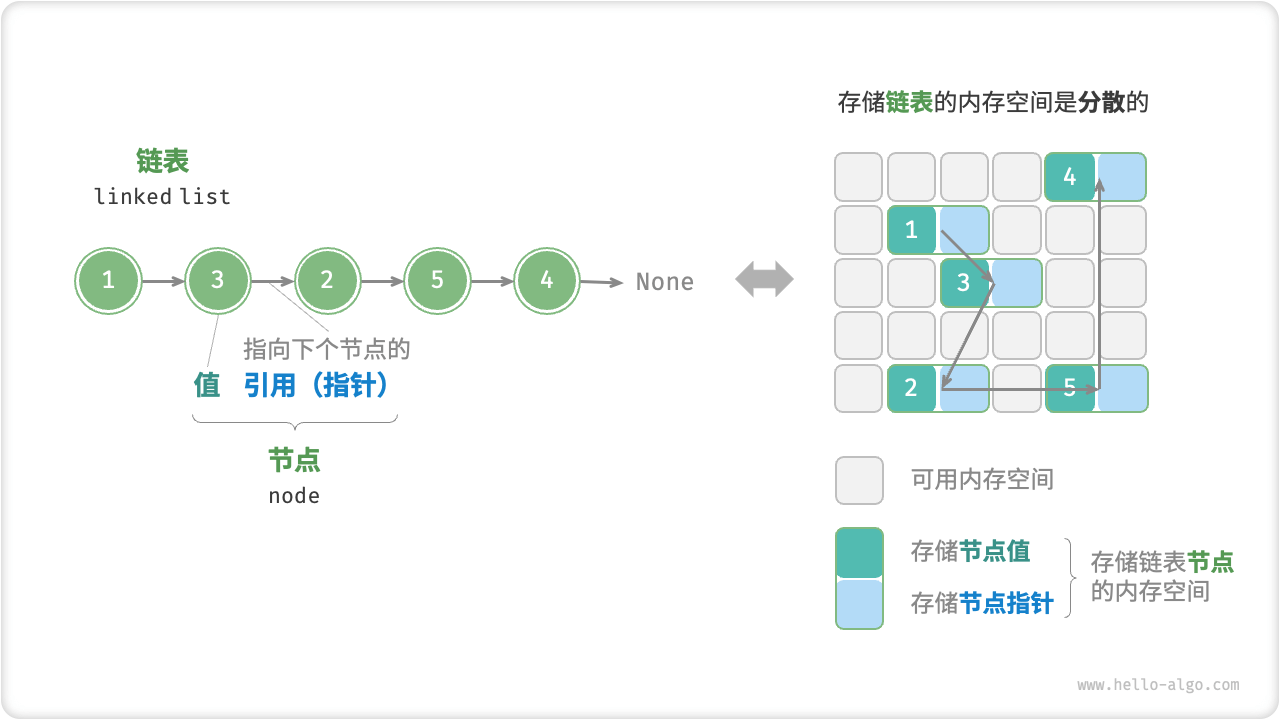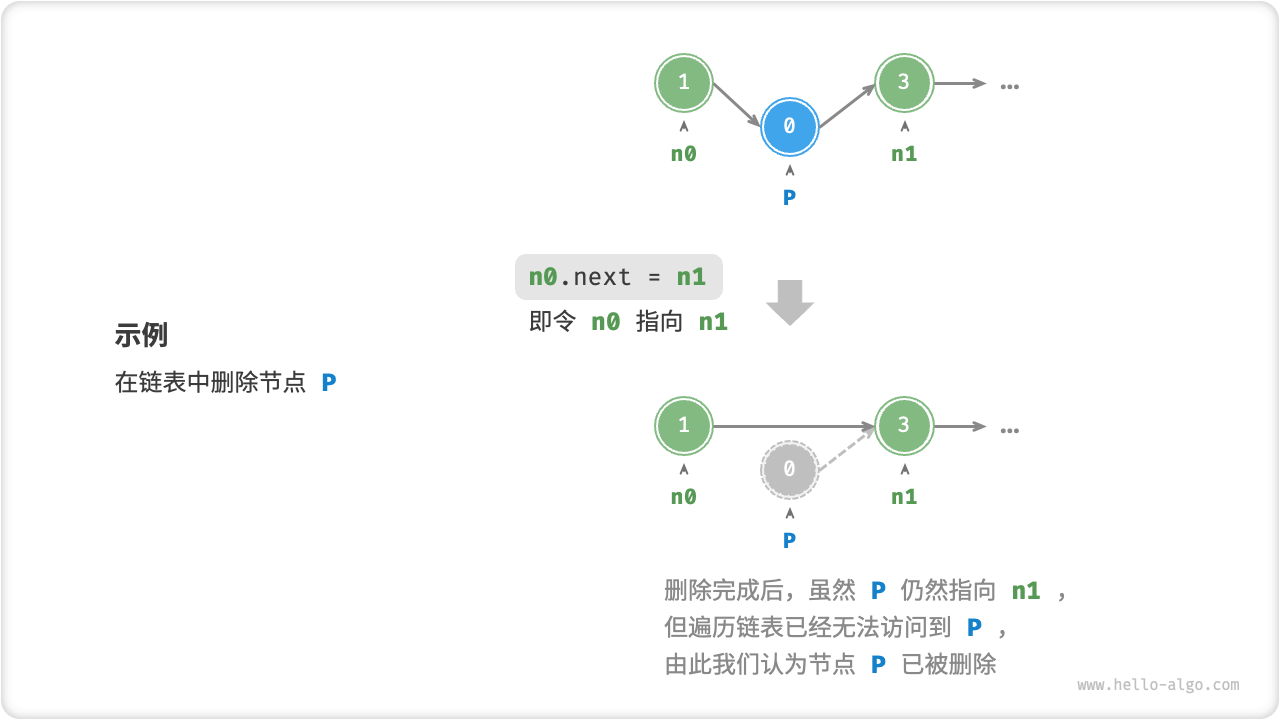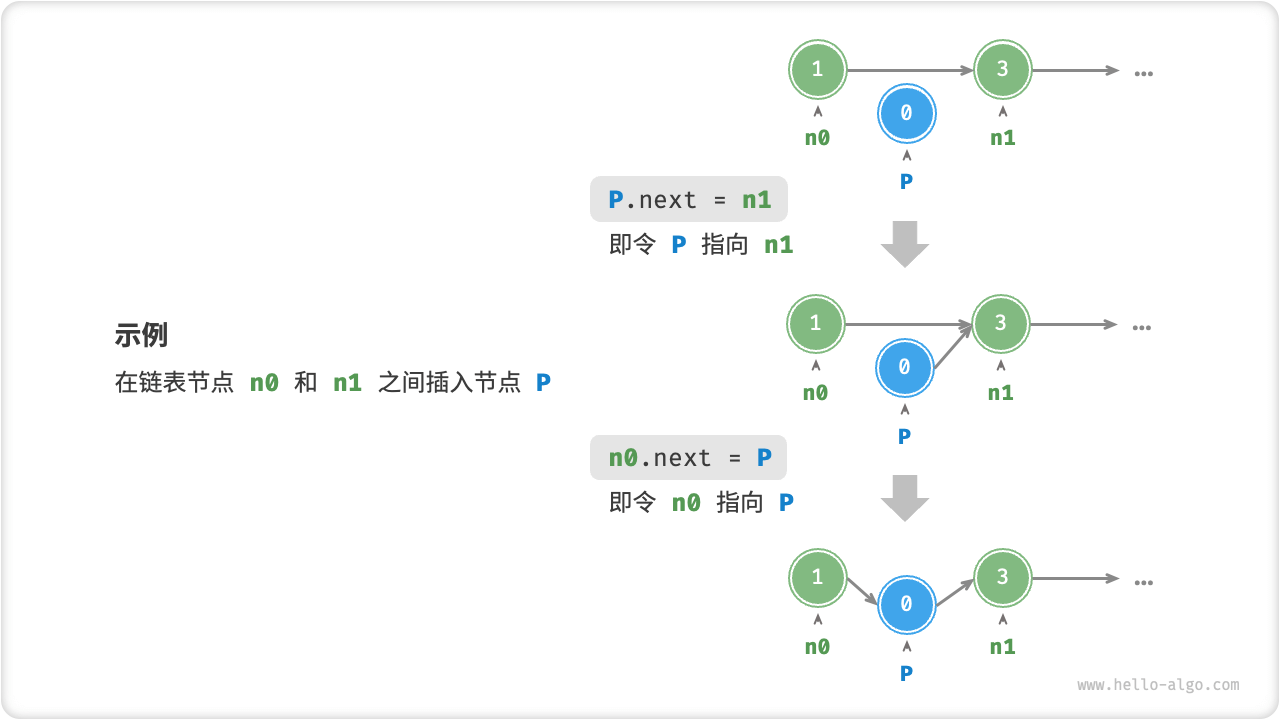LinkedList 源码解析
# 1、链表概念
- LinkedList 实现了List接口和Deque接口,所以它既可以看作一个列表(List),又可以看作一个队列(Queue),那也就可以作为栈(Stack)。
- LinkedList 可以作为列表、栈、队列、双向队列使用。可以说是很强大了。但如果栈或队列,首选还是ArrayDeque,因为它的性能会比LinkedList更好。
- LinkedList 底层是双向链表,所以它支持高效的插入和删除操作,但是不支持随机访问。
链表概念
链表是一种线性数据结构,其中的每个元素都是一个节点对象,各个节点通过“引用”相连接。引用记录了下一个节点的内存地址,通过它可以从当前节点访问到下一个节点。链表比数组占用更多的内存空间。

源码
public class LinkedList<E>
extends AbstractSequentialList<E>
implements List<E>, Deque<E>, Cloneable, java.io.Serializable
{
// ...
}
2
3
4
5
6
# 2、变量参数说明
LinkedList 的参数主要记录了链表的节点个数、第一个节点和最后一个节点。
源码
transient int size = 0;
/**
* Pointer to first node.
* Invariant: (first == null && last == null) ||
* (first.prev == null && first.item != null)
*/
transient Node<E> first;
/**
* Pointer to last node.
* Invariant: (first == null && last == null) ||
* (last.next == null && last.item != null)
*/
transient Node<E> last;
2
3
4
5
6
7
8
9
10
11
12
13
14
15
transient int size:表示LinkedList中元素的个数。被标记为transient的成员变量不会被序列化保存和恢复,这是因为LinkedList的大小可以通过遍历链表计算得到,所以不需要序列化保存和恢复该值。transient Node first:表示链表的第一个节点。被标记为transient的成员变量不会被序列化保存和恢复,因为根据链表结构,first指针可以重建。transient Node last:表示链表的最后一个节点。被标记为transient的成员变量不会被序列化保存和恢复,因为根据链表结构,last指针可以重建。
Node源码
private static class Node<E> {
E item;
Node<E> next;
Node<E> prev;
Node(Node<E> prev, E element, Node<E> next) {
this.item = element;
this.next = next;
this.prev = prev;
}
}
2
3
4
5
6
7
8
9
10
11
包含了数据、上一个节点和下一个节点。
# 3、构造函数
LinkedList 提供了两个构造函数,一个无参构造函数和一个包含集合的构造函数。用法和ArrayLi
源码
/**
* Constructs an empty list.
*/
public LinkedList() {
}
/**
* Constructs a list containing the elements of the specified
* collection, in the order they are returned by the collection's
* iterator.
*
* @param c the collection whose elements are to be placed into this list
* @throws NullPointerException if the specified collection is null
*/
public LinkedList(Collection<? extends E> c) {
this();
addAll(c);
}
2
3
4
5
6
7
8
9
10
11
12
13
14
15
16
17
18
# 4、getFirst()和getLast()
获取第一个节点和获取最后一个节点,这个就比较简单,因为LinkedList的内部结构就是由first和last两个指针来维护的。
源码
/**
* Returns the first element in this list.
*
* @return the first element in this list
* @throws NoSuchElementException if this list is empty
*/
public E getFirst() {
final Node<E> f = first;
if (f == null)
throw new NoSuchElementException();
return f.item;
}
/**
* Returns the last element in this list.
*
* @return the last element in this list
* @throws NoSuchElementException if this list is empty
*/
public E getLast() {
final Node<E> l = last;
if (l == null)
throw new NoSuchElementException();
return l.item;
}
2
3
4
5
6
7
8
9
10
11
12
13
14
15
16
17
18
19
20
21
22
23
24
25
# 5、四个remove()方法
removeFirst():移除第一个节点removeLast():移除最后一个节点remove(e):移除指定元素节点remove(index):移除指定下标节点
删除节点

- removeFirst()
将第一个节点置空,并将第二个节点赋值给第一个节点。原来的第一个节点内存就释放移除了。
源码
/**
* Removes and returns the first element from this list.
*
* @return the first element from this list
* @throws NoSuchElementException if this list is empty
*/
public E removeFirst() {
final Node<E> f = first;
if (f == null)
throw new NoSuchElementException();
return unlinkFirst(f);
}
/**
* Unlinks non-null first node f.
*/
private E unlinkFirst(Node<E> f) {
// assert f == first && f != null;
final E element = f.item;
final Node<E> next = f.next;
f.item = null;
f.next = null; // help GC
first = next;
if (next == null)
last = null;
else
next.prev = null;
size--;
modCount++;
return element;
}
2
3
4
5
6
7
8
9
10
11
12
13
14
15
16
17
18
19
20
21
22
23
24
25
26
27
28
29
30
31
32
- removeLast()
直接将最后最后一个节点置空,并将LinkedList中记录的最后一个节点执行最后一个节点的上一个节点。
源码
/**
* Removes and returns the last element from this list.
*
* @return the last element from this list
* @throws NoSuchElementException if this list is empty
*/
public E removeLast() {
final Node<E> l = last;
if (l == null)
throw new NoSuchElementException();
return unlinkLast(l);
}
/**
* Unlinks non-null last node l.
*/
private E unlinkLast(Node<E> l) {
// assert l == last && l != null;
final E element = l.item;
final Node<E> prev = l.prev;
l.item = null;
l.prev = null; // help GC
last = prev;
if (prev == null)
first = null;
else
prev.next = null;
size--;
modCount++;
return element;
}
2
3
4
5
6
7
8
9
10
11
12
13
14
15
16
17
18
19
20
21
22
23
24
25
26
27
28
29
30
31
- remove(e)
移除指定元素,判断的依据是equals方法, 如果equals,则直接unlink这个node;由于LinkedList可存放null元素,故也可以删除第一次出现null的元素。
源码
/**
* Removes the first occurrence of the specified element from this list,
* if it is present. If this list does not contain the element, it is
* unchanged. More formally, removes the element with the lowest index
* {@code i} such that
* <tt>(o==null ? get(i)==null : o.equals(get(i)))</tt>
* (if such an element exists). Returns {@code true} if this list
* contained the specified element (or equivalently, if this list
* changed as a result of the call).
*
* @param o element to be removed from this list, if present
* @return {@code true} if this list contained the specified element
*/
public boolean remove(Object o) {
if (o == null) {
for (Node<E> x = first; x != null; x = x.next) {
if (x.item == null) {
unlink(x);
return true;
}
}
} else {
for (Node<E> x = first; x != null; x = x.next) {
if (o.equals(x.item)) {
unlink(x);
return true;
}
}
}
return false;
}
/**
* Unlinks non-null node x.
*/
E unlink(Node<E> x) {
// assert x != null;
final E element = x.item;
final Node<E> next = x.next;
final Node<E> prev = x.prev;
if (prev == null) {// 第一个元素
first = next;
} else {
prev.next = next;
x.prev = null;
}
if (next == null) {// 最后一个元素
last = prev;
} else {
next.prev = prev;
x.next = null;
}
x.item = null; // GC
size--;
modCount++;
return element;
}
2
3
4
5
6
7
8
9
10
11
12
13
14
15
16
17
18
19
20
21
22
23
24
25
26
27
28
29
30
31
32
33
34
35
36
37
38
39
40
41
42
43
44
45
46
47
48
49
50
51
52
53
54
55
56
57
58
59
60
- remove(index)
使用的是下标计数, 只需要判断该index是否有元素即可,如果有则直接unlink这个node。
源码
/**
* Removes the element at the specified position in this list. Shifts any
* subsequent elements to the left (subtracts one from their indices).
* Returns the element that was removed from the list.
*
* @param index the index of the element to be removed
* @return the element previously at the specified position
* @throws IndexOutOfBoundsException {@inheritDoc}
*/
public E remove(int index) {
checkElementIndex(index);
return unlink(node(index));
}
2
3
4
5
6
7
8
9
10
11
12
13
# 6、add()和addAll()
插入节点

- add() 插入节点,提供了两种方式,一种是直接插入,一种是插入到指定位置。
源码
/**
* Appends the specified element to the end of this list.
*
* <p>This method is equivalent to {@link #addLast}.
*
* @param e element to be appended to this list
* @return {@code true} (as specified by {@link Collection#add})
*/
public boolean add(E e) {
linkLast(e);
return true;
}
/**
* Links e as last element.
*/
void linkLast(E e) {
final Node<E> l = last;
final Node<E> newNode = new Node<>(l, e, null);
last = newNode;
if (l == null)
first = newNode;
else
l.next = newNode;
size++;
modCount++;
}
/**
* Inserts the specified element at the specified position in this list.
* Shifts the element currently at that position (if any) and any
* subsequent elements to the right (adds one to their indices).
*
* @param index index at which the specified element is to be inserted
* @param element element to be inserted
* @throws IndexOutOfBoundsException {@inheritDoc}
*/
public void add(int index, E element) {
checkPositionIndex(index);
if (index == size)
linkLast(element);
else
linkBefore(element, node(index));
}
2
3
4
5
6
7
8
9
10
11
12
13
14
15
16
17
18
19
20
21
22
23
24
25
26
27
28
29
30
31
32
33
34
35
36
37
38
39
40
41
42
43
44
45
- 尾部插入:直接将最后一个节点的下一个节点指向下一个节点即可。
- 指定位置插入:当index==size时,等同于add(E e); 如果不是,则分两步:
- 先根据index找到要插入的位置,即node(index)方法。
- 修改引用,完成插入操作。
node(int index)源码
/**
* Returns the (non-null) Node at the specified element index.
*/
Node<E> node(int index) {
// assert isElementIndex(index);
if (index < (size >> 1)) {
Node<E> x = first;
for (int i = 0; i < index; i++)
x = x.next;
return x;
} else {
Node<E> x = last;
for (int i = size - 1; i > index; i--)
x = x.prev;
return x;
}
}
2
3
4
5
6
7
8
9
10
11
12
13
14
15
16
17
18
- addAll()
addAll(index, c) 实现方式并不是直接调用add(index,e)来实现,主要是因为效率的问题,另一个是fail-fast中modCount只会增加1次。而是单独循环插入。
源码
/**
* Appends all of the elements in the specified collection to the end of
* this list, in the order that they are returned by the specified
* collection's iterator. The behavior of this operation is undefined if
* the specified collection is modified while the operation is in
* progress. (Note that this will occur if the specified collection is
* this list, and it's nonempty.)
*
* @param c collection containing elements to be added to this list
* @return {@code true} if this list changed as a result of the call
* @throws NullPointerException if the specified collection is null
*/
public boolean addAll(Collection<? extends E> c) {
return addAll(size, c);
}
/**
* Inserts all of the elements in the specified collection into this
* list, starting at the specified position. Shifts the element
* currently at that position (if any) and any subsequent elements to
* the right (increases their indices). The new elements will appear
* in the list in the order that they are returned by the
* specified collection's iterator.
*
* @param index index at which to insert the first element
* from the specified collection
* @param c collection containing elements to be added to this list
* @return {@code true} if this list changed as a result of the call
* @throws IndexOutOfBoundsException {@inheritDoc}
* @throws NullPointerException if the specified collection is null
*/
public boolean addAll(int index, Collection<? extends E> c) {
checkPositionIndex(index);
Object[] a = c.toArray();
int numNew = a.length;
if (numNew == 0)
return false;
Node<E> pred, succ;
if (index == size) {
succ = null;
pred = last;
} else {
succ = node(index);
pred = succ.prev;
}
for (Object o : a) {
@SuppressWarnings("unchecked") E e = (E) o;
Node<E> newNode = new Node<>(pred, e, null);
if (pred == null)
first = newNode;
else
pred.next = newNode;
pred = newNode;
}
if (succ == null) {
last = pred;
} else {
pred.next = succ;
succ.prev = pred;
}
size += numNew;
modCount++;
return true;
}
2
3
4
5
6
7
8
9
10
11
12
13
14
15
16
17
18
19
20
21
22
23
24
25
26
27
28
29
30
31
32
33
34
35
36
37
38
39
40
41
42
43
44
45
46
47
48
49
50
51
52
53
54
55
56
57
58
59
60
61
62
63
64
65
66
67
68
69
# 7、set()和get()
set()是指定位置重新赋值,get()获取指定位置的值。
源码
/**
* Replaces the element at the specified position in this list with the
* specified element.
*
* @param index index of the element to replace
* @param element element to be stored at the specified position
* @return the element previously at the specified position
* @throws IndexOutOfBoundsException {@inheritDoc}
*/
public E set(int index, E element) {
checkElementIndex(index);
Node<E> x = node(index);
E oldVal = x.item;
x.item = element;
return oldVal;
}
/**
* Returns the element at the specified position in this list.
*
* @param index index of the element to return
* @return the element at the specified position in this list
* @throws IndexOutOfBoundsException {@inheritDoc}
*/
public E get(int index) {
checkElementIndex(index);
return node(index).item;
}
2
3
4
5
6
7
8
9
10
11
12
13
14
15
16
17
18
19
20
21
22
23
24
25
26
27
28
# 8、clear()
清空不是直接将LinkedList设为null,而是要将每个节点内存释放。为了让GC更快可以回收放置的元素,需要将node之间的引用关系赋空。
源码
/**
* Removes all of the elements from this list.
* The list will be empty after this call returns.
*/
public void clear() {
// Clearing all of the links between nodes is "unnecessary", but:
// - helps a generational GC if the discarded nodes inhabit
// more than one generation
// - is sure to free memory even if there is a reachable Iterator
for (Node<E> x = first; x != null; ) {
Node<E> next = x.next;
x.item = null;
x.next = null;
x.prev = null;
x = next;
}
first = last = null;
size = 0;
modCount++;
}
2
3
4
5
6
7
8
9
10
11
12
13
14
15
16
17
18
19
20
# 9、查找
LinkedList 底层是链表,查找起来就得通过循环去找。所以查找效率不如ArrayList。我们看两个查找方法,indexOf(Object o)和lastIndexOf(Object o)
indexOf(Object o)查找第一次出现的index, 如果找不到返回-1;
/**
* Returns the index of the first occurrence of the specified element
* in this list, or -1 if this list does not contain the element.
* More formally, returns the lowest index {@code i} such that
* <tt>(o==null ? get(i)==null : o.equals(get(i)))</tt>,
* or -1 if there is no such index.
*
* @param o element to search for
* @return the index of the first occurrence of the specified element in
* this list, or -1 if this list does not contain the element
*/
public int indexOf(Object o) {
int index = 0;
if (o == null) {
for (Node<E> x = first; x != null; x = x.next) {
if (x.item == null)
return index;
index++;
}
} else {
for (Node<E> x = first; x != null; x = x.next) {
if (o.equals(x.item))
return index;
index++;
}
}
return -1;
}
2
3
4
5
6
7
8
9
10
11
12
13
14
15
16
17
18
19
20
21
22
23
24
25
26
27
28
lastIndexOf(Object o)查找最后一次出现的index, 如果找不到返回-1;
/**
* Returns the index of the last occurrence of the specified element
* in this list, or -1 if this list does not contain the element.
* More formally, returns the highest index {@code i} such that
* <tt>(o==null ? get(i)==null : o.equals(get(i)))</tt>,
* or -1 if there is no such index.
*
* @param o element to search for
* @return the index of the last occurrence of the specified element in
* this list, or -1 if this list does not contain the element
*/
public int lastIndexOf(Object o) {
int index = size;
if (o == null) {
for (Node<E> x = last; x != null; x = x.prev) {
index--;
if (x.item == null)
return index;
}
} else {
for (Node<E> x = last; x != null; x = x.prev) {
index--;
if (o.equals(x.item))
return index;
}
}
return -1;
}
2
3
4
5
6
7
8
9
10
11
12
13
14
15
16
17
18
19
20
21
22
23
24
25
26
27
28
# 10、Queue常用方法概览
Queue(队列)是一种遵循先进先出(FIFO)原则的集合。
| 方法 | 说明 |
|---|---|
| boolean add(E e) | 将指定的元素插入此队列的尾部。如果队列已满,则抛出一个IllegalStateException异常。 |
| boolean offer(E e) | 将指定的元素插入此队列的尾部。如果队列已满,则返回false。 |
| E remove() | 移除并返回队列头部的元素。如果队列为空,则抛出一个NoSuchElementException异常。 |
| E poll() | 移除并返回队列头部的元素。如果队列为空,则返回null。 |
| E element() | 返回队列头部的元素。如果队列为空,则抛出一个NoSuchElementException异常。 |
| E peek() | 返回队列头部的元素。如果队列为空,则返回null。 |
| boolean isEmpty() | 如果队列为空,返回true;否则返回false。 |
| int size() | 返回队列中的元素个数。 |
| void clear() | 移除队列中的所有元素。 |
# 11、Deque常用方法概览
Deque(双端队列)是一种可以在两端(头和尾)进行操作的队列。Deque接口继承自Queue接口,因此拥有Queue的一些方法,同时还拥有一些新增的方法。
| 方法 | 说明 |
|---|---|
| void addFirst(E e) | 将元素添加到双端队列的头部。 |
| void addLast(E e) | 将元素添加到双端队列的尾部。 |
| boolean offerFirst(E e) | 将元素添加到双端队列的头部,并返回添加是否成功。 |
| boolean offerLast(E e) | 将元素添加到双端队列的尾部,并返回添加是否成功。 |
| E removeFirst() | 移除并返回双端队列的头部元素。如果队列为空,则抛出NoSuchElementException异常。 |
| E removeLast() | 移除并返回双端队列的尾部元素。如果队列为空,则抛出NoSuchElementException异常。 |
| E pollFirst() | 移除并返回双端队列的头部元素。如果队列为空,则返回null。 |
| E pollLast() | 移除并返回双端队列的尾部元素。如果队列为空,则返回null。 |
| E getFirst() | 返回双端队列的头部元素,但不移除元素。如果队列为空,则抛出NoSuchElementException异常。 |
| E getLast() | 返回双端队列的尾部元素,但不移除元素。如果队列为空,则抛出NoSuchElementException异常。 |
| E peekFirst() | 返回双端队列的头部元素,但不移除元素。如果队列为空,则返回null。 |
| E peekLast() | 返回双端队列的尾部元素,但不移除元素。如果队列为空,则返回null。 |
| boolean removeFirstOccurrence(Object o) | 移除双端队列中首次出现的指定元素。 |
| boolean removeLastOccurrence(Object o) | 移除双端队列中最后一次出现的指定元素。 |
